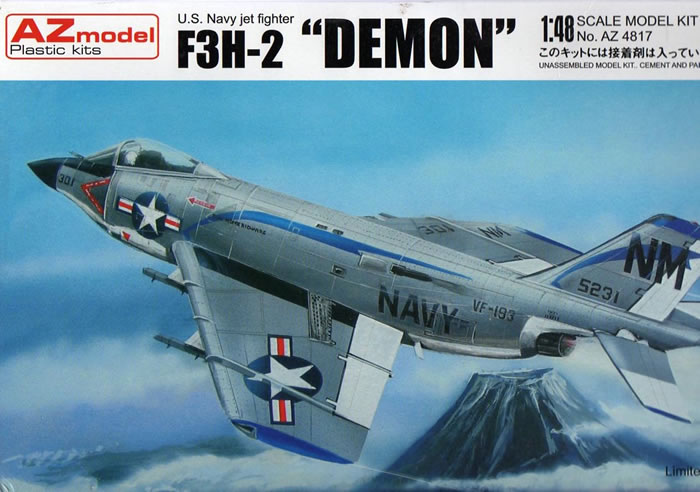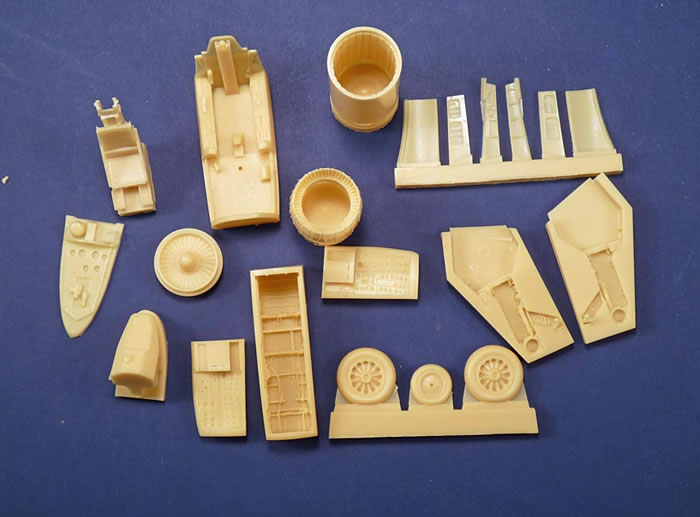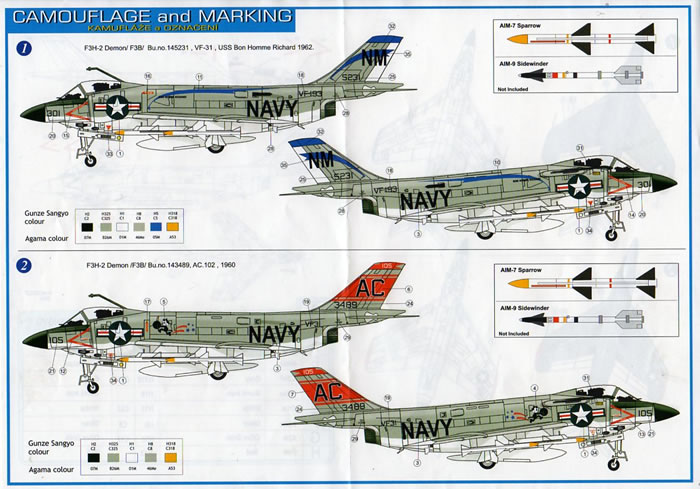F3H-2 “Demon”

AZ Model, 1/48 scale
S u m m a r y : |
Catalogue Number: |
AZ Model Kit Number AZ4816 - F3H-2 “Demon” |
Scale: |
1/48 |
Contents & Media |
78 parts in grey styrene, 2 parts in clear injection molding, 74 parts in cream colored resin, 27 etched metal parts and one printed acetate. Instructions and decal sheet for two aircraft. |
Price: |
USD$56.98 available online from UMM-USA |
Review Type: |
First Look |
Advantages: |
One can make nearly every variant of the F3H Demon. Large amounts of resin and photo etch, and a good price point. |
Disadvantages: |
You might need to get aftermarket decals, as the ones in the kit are prone to shattering. |
Conclusions: |
A very nice model for anyone interested in US Navy jet aviation. Great value. |
Reviewed by Steven Eisenman

HyperScale is proudly supported by Squadron.com
It seems that the original issue of this model back in 2004 under the Grand Phoenix label of Aeromaster showed quite a degree of prescience. Arising from the ashes of Aeromaster /Grand Phoenix, the 1/48 F3H-2 Demon continues on under the AZmodel label of Legatokits, which, I believe, was the company that produced the kit for Grand Phoenix.
The amazing part is that like the legendary Phoenix, which arose anew, the AZnmodel shows no signs of aging. There is virtually no flash on the injection molded parts and the fine engraved panel lines are still very sharp and crisp and the clear parts are quite clear.
The kit still includes the bounty of resin, etched metal and painting masks that were in the original Grand Phoenix boxing.
But best of all, the price is much less than the MSRP back in 2004.
When I received this kit, my first task, after oooing and ahhhing over what was in the box, was to quickly educate myself about this aircraft. Not having any books on the F3H Demon, I went to the Internet. What I came away with was a bit of confusion about the differences between the -2, -2N and -2M. Did the -2 come first or after the -2N and -2M? Was the short tail associated with any given model? And a host of other questions.
But what I was able to come away with enough information, hopefully correct, to determine what versions of the F3H Demon could be made from the parts in the box. What I discovered was that, while the kit is labeled as a F3H-2 Demon, virtually every variation of the F3H could be made form this kit, except for the -1 variants. The instruction sheet is, in fact, labeled F3H-2, F3H-2M.
Let me try to walk through this tangle and excuse me if I should stumble. First, let’s exclude all the electronic and internal technical aspects of the aircraft.

It is my understanding that the F3H-2N was equipped with four 20mm cannon and could carry Sparrow II missiles. Well, the kit does have inserts for the four cannons in the nose and it does come with Sparrow missiles. Whether they are Sparrow II or Sparrow III missiles, I am unable to determine.
Next, I understand that the -2N often had two cannon eliminated. This kit also comes with inserts for only one cannon on each side.
Then we go to the -3M. It is my understanding that this aircraft was to be a dedicated missile carrying aircraft without cannon. While the kit does not have an insert without cannons, it would seem quite easy just to fill in the cannon depression on the single gun inserts with some putty. As noted above, there are four Sparrow missiles.
If you want to add Sidewinders, which could also be carried, you will need to provide those.
As to the -2, without any letter designation, it seems that the number of hardpoints was increased to a total six, with the two additional hardpoints on the fuselage. The kit, however, only includes a total of four hardpoints under the wings for missiles. The two in the kit for the fuselage are to accommodate the fuel tanks, I am not sure they are appropriate in design for missiles.
It should be noted that while the instructions show the building of the missile and attaching it to the hard point, it does not show where the completed missile assemblies should be placed under the wings. You are left entirely to your own devices on this one. Odd indeed.
Then there is the issue of long tail and short tail versions of the F3H. It appears that the short tailed F3H was associated with -2 model (without letter designation), and was introduced in the production run beginning with Bureau Number 143403. Although not packed in the bags of resin, I did find resin part 52, the short “beaver tail”, packed in with the plastic parts. Of course, the kit does come with the long tail in plastic.
Based on the instructions, assembly appears to be quite straightforward. But, from previous reviews, it clearly is not a “make and take snap fit” or “even a shake and bake”. While some moderate modeling experience may be needed in working with the resin and etched metal, construction would not appear problematic. None of the molding blocks on the resin pieces appear to present real problems for removal.
Even though the instructions do not indicate, some weight in the nose would be needed. Given the sit of the aircraft, I would err on the side of too much, rather then too little.
Markings:
Markings are provided for two aircraft, both in the USN Light Gull Gray and White scheme.
-
VF-193, USS Bon Homme Richard, 1962. The marking guide indicates that this is an aircraft of VF-31. Its seems they got the Bon Homme Rischard’s carrier designation, CV 31, confused with a squadron number.
-
VF-3 1, USS Saratoga, circa 1960. The marking guide indicates neither the squadron nor the carrier.
I also wonder if the guide has the correct Bu.No. Both are numbers higher than 143403, yet they show long tailed Demons. However, I also came across a picture showing a tail serial number of 5299. I presume this would be Bu. No. 145299 (Navy Air guys?). The aircraft pictured appears to be a long tailed F3H. So much for Bu.No. reference points. It also appears to be an F3H-2N. As I noted earlier, confusion is the order of the day.

As for the decals themselves, they are nicely printed and all in register. But they are not without problems. The only attribution printed on them is AZ Models. The problem is that they performed like typical old-fashioned Eastern European decals. They gripped as soon as they touched plastic, even with the use of Micro Set, and became set in place. Attempts to move them resulted in a shattered decal.
After looking at this kit of the F3H-2, and taking all things into consideration it leaves me scratching my head in wonderment. Not because the kit is bad, or because it is a great package at a great price, but because no one seems to build it.
In a quick search I came across four examples of a built G-P or AZ model F3H: One at Hyperscale, one at ARC and two at Modeling Madness, both of which were built for a review article.
Perhaps I am missing something. This appears to be a great kit, with few complaints and more positives than negatives. Yet even with a kit like this, modelers ask for models of other USN Jets, which perhaps will be issued and like the Demon not be bought or built, at least for public display.
Even if the decals are not up to the best from Microscale or are not markings you like, there are still aftermarket sets available from Eagle Strike at Squadron Mail Order. Just search 1/48 - Eagle Strike Decals –Demon. You’ll find markings for six more aircraft.
I’m not really a jet modeler. But after taking a close look at the AZ Models F3H-2 Demon, this one will go into the pile for a near future build, rather than in the stash.
References
http://www.ccdemo.info/AircraftPix/Demon.html
http://www.boeing.com/history/mdc/demon.htm
http://home.att.net/~jbaugher1/f3_3.html
http://en.wikipedia.org/wiki/F3H_Demon
Thanks to John Vojtech of UMM-USA for the review sample.
Review Text Copyright © 2009 by Steven Eisenman
Page Created 13 July, 2009
Last updated
13 July, 2009
Back to HyperScale Main Page
Back to Reviews Page

|
Home
| What's New |
Features |
Gallery |
Reviews |
Reference |
Forum |
Search